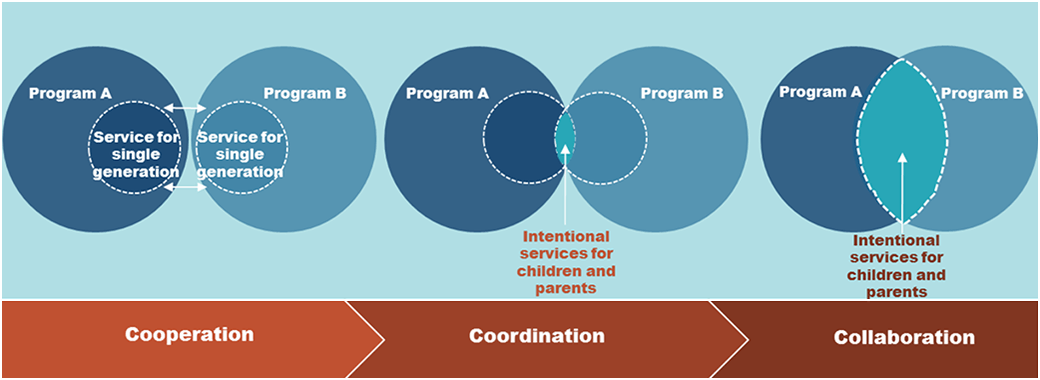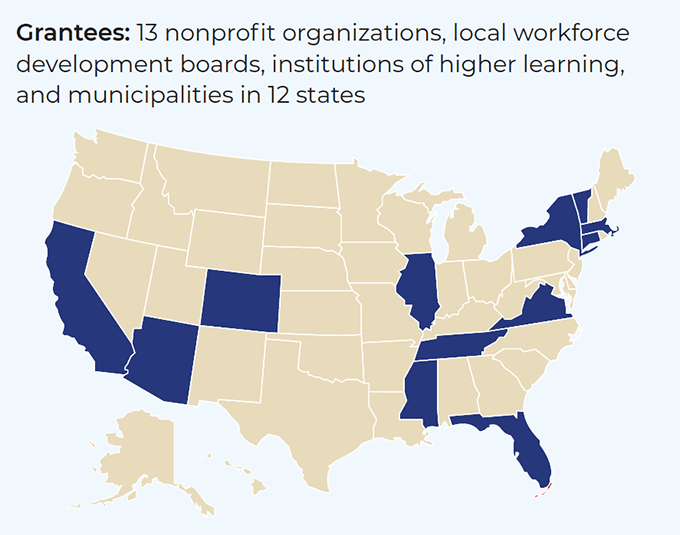
Scott Baumgartner
Senior Researcher
View Bio PagePrograms that support family economic security and early childhood development are administered by a variety of federal, state, and nongovernmental agencies. This complex landscape can make it difficult for service providers to assist families with complex needs and ensure that services for parents and their children are mutually reinforcing. Parents with young children in early care and education programs, like Early Head Start, may also need education and training guidance or economic support through community colleges or workforce development programs. Intentional coordination may lead to benefits for families that are greater than what individual service providers could achieve alone. However, coordinating services requires systems change through active partnerships, engaged leadership, joint planning, data-informed decision making, strategic use of resources, and innovative problem solving.
Among the programs supporting families with complex needs, such as Head Start, many service providers focus on multilayered, multigenerational outcomes. Several initiatives aim to better understand the variety of programs and coordinated services by documenting specific approaches. One initiative, Integrated Approaches to Supporting Child Development and Improving Family Economic Security, documented programs that intentionally combine services for parents and children, sometimes called “two-generation” or “dual generation” programs, to help families move toward economic security and create conditions that promote child and family well-being. Of the two-generation programs identified, 25 percent originated as child-focused programs, 25 percent were developed to serve parents and children together, about 20 percent provided housing and supportive services for single mothers and their children, 13 percent of programs added child services to their adult services, and 15 percent operated as close partnerships between two or more organizations. Their service models blended multiple offerings for parents and children to meet the needs of individual families. A recent literature review revealed that quality and intensity may need to be at high levels for programs to have an impact on parent and child outcomes.
It’s led to the development of a partnership framework (pictured below) which shows how partnerships tend to evolve through stages of cooperation, coordination, and collaboration.

The Assessing Models of Coordinated Services project aimed to fill gaps in understanding how states and communities coordinate early care and education, family economic security, and/or other health and human services to support the well-being of children and their families. Through a scan of publicly available information, we identified 95 coordinated services approaches that met our project criteria. The interactive map below, created by the Office of Planning, Research, and Evaluation (OPRE) and located on their website, depicts the coordinated services approaches identified in the scan of public information.
Through Models of Coordination and Technical Assistance to Achieve Outcomes in Communities, Mathematica is working to help communities improve and increase collaboration across different sectors, such as child care programs, health services, and employment training. Support from the federal government can bolster local efforts to drive change and provide on-the-ground assistance. For example, programs can tailor training and technical assistance (T/TA) based on community needs while also streamlining efforts to achieve targeted outcomes.
Another project, the Strengthening Working Families Initiative (SWFI) developed by the U.S. Department of Labor, sought to help low- and middle-skilled parents gain training and education to obtain jobs in high-growth or in-demand industries. SWFI grantees, which represent partnerships of public and private organizations, aimed to increase access to education and training opportunities by mitigating barriers for parents, particularly those related to child care. SWFI grantees addressed parents’ training and supportive service needs through program-level activities and implemented sustainable local changes to help families navigate the workforce and child care systems.

Two-generation programs that integrate early care and education with adult education and employment services can help families attain economic security and reach their goals. Next Steps for Rigorous Research on Two-Generation Programs (NS2G) is expanding upon results from the Integrated Approaches project by building the capacity of a group of two-generation programs that aim to support child development and family economic security. These approaches hold promise for breaking cycles of intergenerational poverty. Over the next four years, the project team will apply lessons learned from Integrated Approaches to strengthen selected two generation programs, extend the lessons from those activities to the broader field, and prepare a subset of programs for potential future summative evaluation.
NS2G and other projects are working with programs to implement rapid-cycle testing approaches to their formative evaluations. Rapid-cycle testing is a rigorous, scientific approach to provide decision makers with timely and actionable evidence of whether operational changes improve program outcomes. Often, changes can be tested in a matter of months, and decision makers can have a high degree of confidence in the results. Such testing can help avoid investments in changes that are unlikely to produce the desired results.
Agape and the Annie E. Casey Foundation sought to refine their approach to two generation programming to deepen the supports families received. Communities of color and communities experiencing poverty have often faced the most significant disparities in gaining access to services, enrolling in services, and completions of services. Mathematica partnered with the Annie E. Casey Foundation to bring culturally responsive best practices and innovative methods to address these challenges. The study team identified several opportunities for Agape to bolster two-generation programming. Key recommendations include:
Building on this work, Agape, Mathematica, and the Annie E. Casey Foundation have continued to work together to strengthen Agape’s capacity to serve communities during the COVID-19 pandemic.
Mathematica worked with the Office of the Assistant Secretary for Planning and Evaluation at the U.S. Department of Health and Human Services to conduct a crosscutting examination of the use of performance measures, work requirements, and child support requirements among human services programs that promote self-sufficiency. Based on discussions with key stakeholders and program staff at the federal, state, and local levels, four key considerations emerged for creating a framework of performance indicators that can align with program goals and be used across human services and workforce programs:
For more information about any of these projects or to speak with a Mathematica expert, please send an email to Info@mathematica-mpr.com.